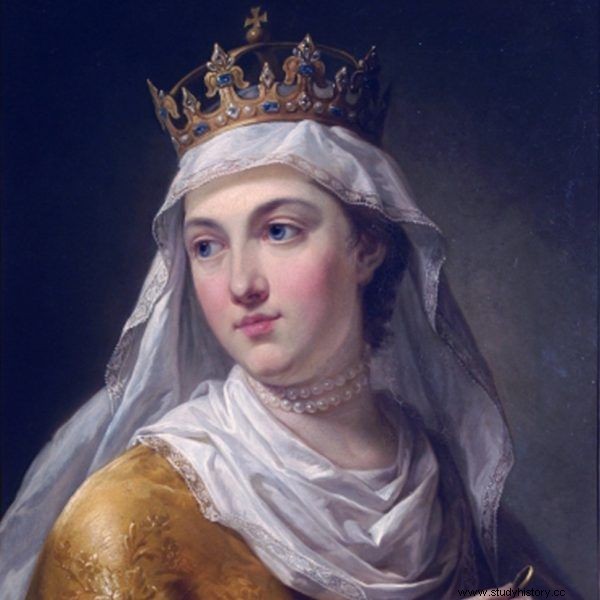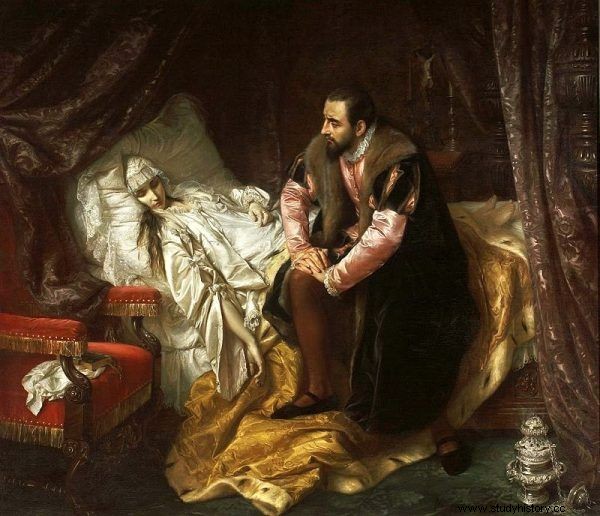There have been more queens than kings in our history. And this is not why, during the monarchy, Poland was somehow an eminently feminist country. It's just that the ladies - much more often than their husbands - had to say goodbye to this world prematurely. What were the causes of their deaths?
The appointment of the heir to the throne (and preferably also a few "spare" candidates for the crown) was the most important task of the royal wife for centuries. A task no less dangerous than going to war - as a result of complications related to childbirth even in the Enlightenment, even every third woman died.
Deadly motherhood
The reasons were varied - lack of knowledge of obstetric techniques, not sewing the uterus after cesarean section surgery, and above all - insufficient hygiene (after all, the rules of asepsis and antiseptics, introduced in the 19th century by Joseph Lister, were not known yet). Janusz Kubicki emphasizes:
Determining the cause of these perinatal deaths in the light of the records of chroniclers (including Jan Długosz), "medics" and other witnesses is very difficult and controversial.
It seems that the causes of death during the birth of Polish queens were: abnormal structure of the spine and bone pelvis (possibly tuberculosis), young age of queens, perinatal infections (today's sepsis) . There is no mention in any historiographic records that the cause of their deaths in childbirth was perinatal hemorrhage.

Queen Jadwiga. Portrait by Marcello Bacciarelli.
In connection with the fulfillment of their "historical" mission, they said goodbye to, among others, the first wife of Sigismund the Old, Barbara Zapolya (from the notes of the queen's secretary it appears that the cause of death was a puerperal infection), Jadwiga Andegaweńska (according to Jan Długosz, "too narrow pelvis" led to her death , but in fact also this time, the culprit was probably the lack of hygiene - the ruler's chambers were located in the so-called Hen Stopce, from where feces were thrown outside the castle) and Anna Austriaczka, the first of the Habsburg wives of Sigismund III Vasa.
In the case of the latter, the poisoning occurred while pregnant - sources describe that the queen suffered from swelling of the limbs, abdomen and face, she probably also had high blood pressure and proteinuria (although it was not possible to state that at the time). She did not survive her fifth birth. . The Venetian physician Jan the Baptist Gemma decided to perform a post-mortem cesarean section, thanks to which Zygmunt had his son Krzysztof alive, but the ruler could soon enjoy it - the newborn died after only 30 minutes.
Treacherous melons and starvation disease
However, even if the royal half managed to survive the childbirth, many dangers awaited her. Due to the - to put it mildly - the poor condition of the old medicine, even an ordinary common cold could be deadly.
Due to an unspecified disease, she died, among others the second wife of Władysław Jagiełło, Anna Cylejska (this ruler was generally unlucky with women, the third chosen one, Elżbieta née Pilcza Granowska, a few years after the wedding were exhausted by consumption, and the fourth - Sonka Holszańska, who survived her very old husband, said goodbye world as a result of indigestion caused by ... eating too many melons.

Anna Jagiellonka did not get married until the age of 52.
Not only marriage was deadly (usually resulting in risky pregnancy and childbirth), but also ... old age. It indirectly contributed to the death of the last representative of the Jagiellonian dynasty, Anna. Admittedly, she lived to the old (for those times) age 73, but due to various debilitating ailments it was not a light and pleasant life, and at its end the ruler repeatedly experienced health breakdowns and attacks of hysteria. Karolina Stojek-Sawicka describes:
Infanta took her old age very badly and most of her illnesses seemed to have a psychological background. From about 1564, that is, from the moment she turned 41, she began to spend more and more money on medicines, doctors and pharmacists (...).
This explains the fact that they appeared during periods when Anna was alone, and in the following years they always intensified during times of bigger problems. For example, Jagiellon began to experience sharp pains when she heard about her sister's imprisonment, and she felt better when Katarzyna was released. He never fully recovered.
Even the late marriage (concluded in 1576; Anna was already in her 50s) did not cure her of the "old age disease". Anyway, the relationship turned out to be not very happy, so it's hardly surprising that love was not a panacea in her case.
Problems of an intimate nature
A too successful relationship could also lead to death. This was supposed to happen in the case of probably the most controversial royal wife in the history of Poland, Barbara Radziwiłłówna. It has been repeated over the years that the prematurely deceased ruler has said goodbye to the world because of a venereal disease. Currently, however, historians tend to favor the version of cervical cancer, the first symptoms of which began to appear in 1549 (two years before the queen's death).

Józef Simmler's painting "The Death of Barbara Radziwiłłówna" (1860).
Bleeding from the genital tract (Barbara initially took them for miscarriages) soon turned into more serious ailments:high fever, ulcers in the intimate spheres, nausea and severe diarrhea. Finally, on May 8, 1551, just six months after her coronation, the suffering Radziwiłłówna died. Zygmunt August did not believe in the natural causes of her death. Marek Ferenc comments:
He was convinced that Barbara (...) had been poisoned and suggested that Bona was behind it. After his wife's death, he wrote to Radziwiłł that he greeted his mother wearing gloves so that she would not give him poison in the ring.
Intimate afflictions also tormented another Polish queen - Maria Kazimiera Sobieska. Her first husband, Jan Sobiepan Zamoyski, infected her with syphilis. "While still ill, she had contacts with Sobieski, who probably also became infected, which could later contribute to his death" - reports Aleksandra Skrzypietz.
Syphilis did not prevent her from having children - with Jan Sobieski she managed to get pregnant 14 times (including once with twins), although only four children lived to adulthood. She herself lived to see her 74th birthday. At the end of her life, little was left of her legendary beauty due to a venereal ailment. As reported by Janusz Kubicki:
She was toothless and most likely bald from mercury treatment. But in the minds of many, she remained the great love of Jan III Sobieski, a flawless lady, beloved raised by the ruler on a pedestal, about which he wrote in his letters to her.
Too healthy queen
Paradoxically, the iron health of the royal wife has also been a problem in our history. Queen Bona Sforza, the wife of Sigismund the Old, learned about it the hard way. The ruler, who practically had nothing to do with her whole life (or at least nothing is known about it), was not even hurt by an accident during a hunt in Niepołomice.

Pappacoda ordered to murder the doctor who gave Bona the poison. He later pronounced a sentence on all the co-conspirators.
Bona - then in her sixth (and as it turned out - in the last) pregnancy - fell off her horse. Worse, she was pinned down by the animal. This led to a miscarriage (the youngest son, an extreme premature baby, was born in a forest clearing and died shortly thereafter), but the monarch herself survived it alive.
She clung to life so tightly that in the end ... she was murdered by her courtier, Jan Lawrence Pappacoda, acting on behalf of the Habsburg dynasty. A grim irony of fate, considering the fact that she herself has been repeatedly accused of poisoning and practicing black magic. Who fights by the sword dies by the sword?
Bibliography:
- K. Janicki, Ladies of the Golden Age, Znak Horyzont 2014.
- J. Kubicki, Perinatal deaths of Polish kings' wives, "Practical Gynecology" 2 (105) / 2010, pp. 46–47.
- J. Kubicki, Wives of the kings and rulers of Poland. History and Medicine, MS Publishing House 2012.
- M. Maciorowski, B. Maciejewska, Rulers of Poland. A story told anew, Agora 2018.
- K. Stojek-Sawicka, Plagi Królewskie, Bellona 2018.
